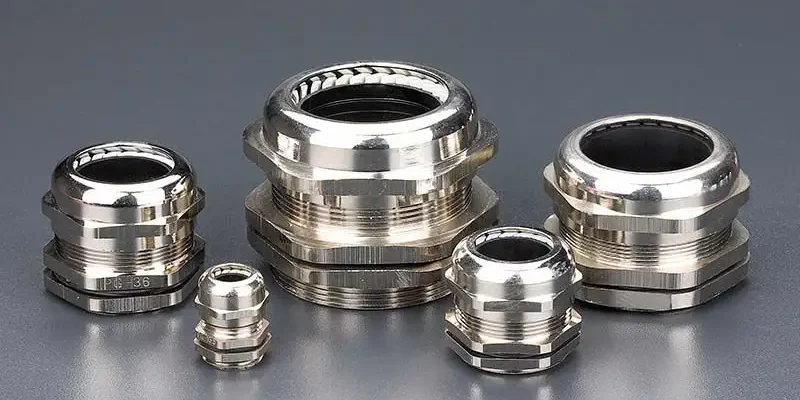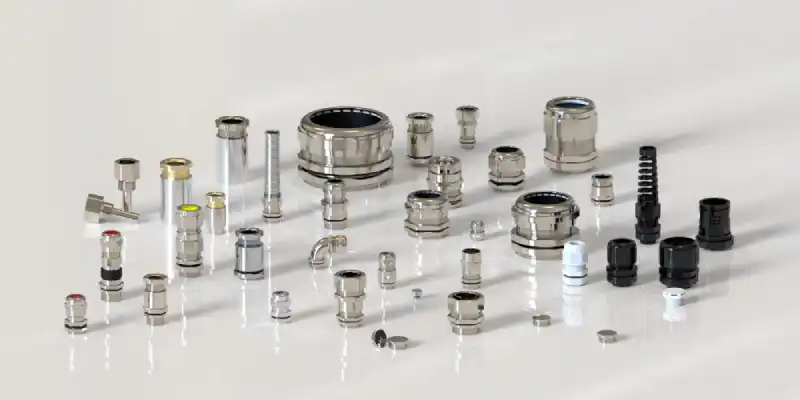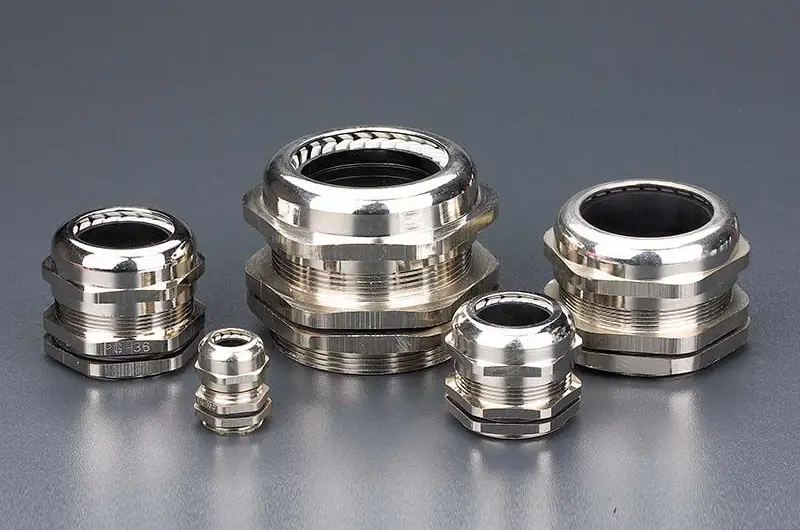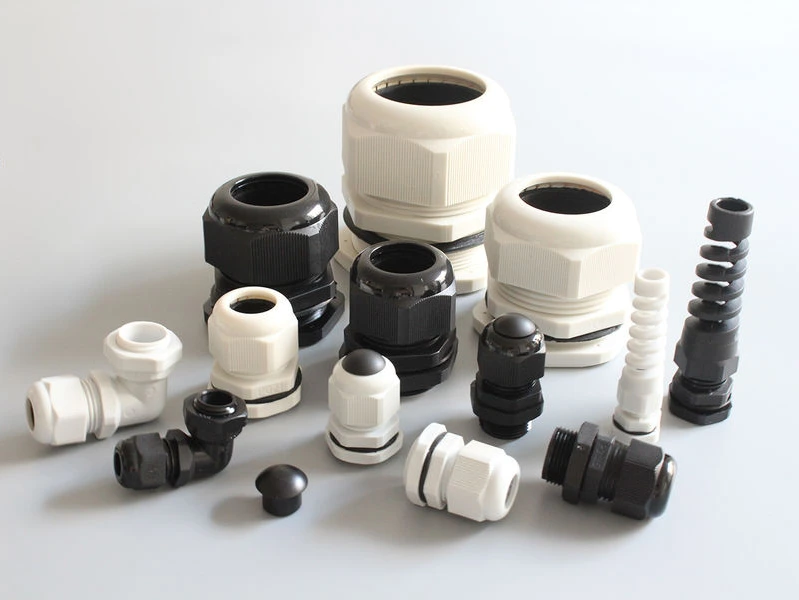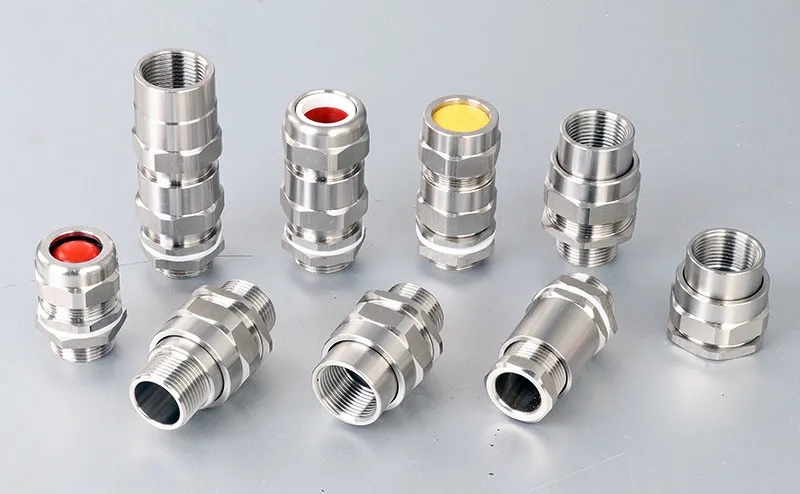تخدم غدد الكابلات، وهي مكونات أساسية في الأنظمة الكهربائية وأنظمة الأجهزة، وظائف حاسمة في تأمين الكابلات وإحكام غلقها وحمايتها في بيئات متنوعة. تجمع هذه المقالة بين المعايير الفنية وعلوم المواد والممارسات الصناعية لتقديم دليل مفصل عن أنواع غدد الكابلات ومنهجيات الاختيار. من خلال فحص الأطر التنظيمية والاعتبارات البيئية والمتطلبات الخاصة بالتطبيقات، يهدف هذا التحليل إلى تزويد المتخصصين بالمعرفة اللازمة لتحسين اختيار غدة الكابلات من أجل السلامة والمتانة والأداء.
تصنيف غدد الكابلات
حسب التركيب المادي
يتم تصنيع غدد الكابلات من مواد مختارة من أجل المتانة ومقاومة التآكل والتوافق مع البيئات التشغيلية.
الغدد المعدنية
- نحاس: يستخدم على نطاق واسع بسبب توصيلته الممتازة ومقاومته للتآكل عند طلائه بالنيكل. مثالي للاستخدامات الصناعية العامة حيث يتوقع حدوث إجهاد ميكانيكي معتدل.
- فولاذ مقاوم للصدأ: مفضل في البيئات شديدة التآكل مثل المنشآت البحرية أو مصانع المعالجة الكيميائية. يوفر مقاومة فائقة للمياه المالحة والأحماض ودرجات الحرارة العالية.
- ألومنيوم: خفيفة الوزن ومقاومة للتآكل في الغلاف الجوي، ومناسبة للتطبيقات الخارجية مع الكابلات المدرعة بالألومنيوم.
الغدد غير المعدنية
- بلاستيك (نايلون/بلاستيك بلاستيكي): حلول فعالة من حيث التكلفة للبيئات منخفضة المخاطر. توفر الغدد البلاستيكية مرونة ومقاومة للأحماض الضعيفة، بينما تتفوق أنواع النايلون في البيئات الغنية بالرطوبة بسبب خصائصها الكارهة للماء.
- مطاطي: تُستخدم هذه الغدد في تطبيقات العزل المائي، وتتضمن هذه الغدد موانع تسرب مطاطية لتحقيق تصنيف IP68، مما يضمن الحماية من دخول المياه ذات الضغط العالي.
حسب التصميم الوظيفي
- الغدد أحادية الضغط: تم تصميم هذه الغدد للكابلات غير المدرعة، وهي مصممة للكابلات غير المدرعة، وتؤمن الغلاف الخارجي عبر آلية إحكام واحدة. تستخدم عادة في التركيبات الداخلية مع الحد الأدنى من الضغوط البيئية.
- غدد الضغط المزدوج: تتميز هذه الغدد بنقطتي إحكام مزدوجة - واحدة للدرع والأخرى للغلاف الداخلي - وهذه الغدد إلزامية للكابلات المدرعة في المناطق الخطرة. فهي تمنع انتقال الغازات وتضمن الاحتفاظ الميكانيكي في ظل الاهتزازات العالية.
- الغدد الحاجزة: معتمدة للأجواء القابلة للانفجار (Ex d)، تستخدم الغدد العازلة مركبات الراتنج لإغلاق مداخل الكابلات، مما يمنع انتشار اللهب. إلزامية في مناطق IEC المنطقة 1/2 ما لم تستوف الكابلات معايير محددة للضغط والحشو.
- غدد EMC: تقوم غدد التوافق الكهرومغناطيسي بحماية الكابلات من التداخل عن طريق تأريض الدرع أو الضفيرة. وهو أمر بالغ الأهمية في أنظمة نقل البيانات والاتصالات السلكية واللاسلكية حيث تكون سلامة الإشارة أمرًا بالغ الأهمية.
المواصفات الفنية والمعايير التنظيمية
تحديثات IEC 60079-14:2024 IEC 60079-14:2024
تقدم مراجعة 2024 متطلبات أكثر صرامة لأنظمة إدخال الكابلات في العبوات المقاومة للاشتعال. تشمل التغييرات الرئيسية ما يلي:
- تفويض غدة الحاجز: يلغي الإعفاءات للكابلات التي يقل طولها عن 3 أمتار في المنطقة 1، مما يتطلب وجود غدد حاجزة بغض النظر عن طول الكابل.
- توافق المواد: إرشادات واضحة بشأن تجنب التآكل الجلفاني عن طريق مطابقة مواد الغدة والحاوية (على سبيل المثال، الغدد المصنوعة من الفولاذ المقاوم للصدأ للحاويات غير القابلة للصدأ).
- بروتوكولات الاختبار: التحقق المحسّن من صحة تصنيفات الحماية من الدخول (IP)، مما يتطلب اختبار الغدد والأختام كنظم متكاملة.
الامتثال لـ NEC/CEC
- تصنيفات الدائرة القصيرة: يجب أن تتحمل الغدد تيارات الأعطال المكافئة لسعة درع الكابل، وعادةً ما يتم التحقق من صلاحيتها من خلال اختبارات UL 514B.
- شهادة المواقع الخطرة: تتطلب الغدد الخاصة بمناطق الفئة الأولى القسم 1 شهادات UL 1203 أو CSA C22.2 رقم 0.6، مما يضمن السلامة ضد الانفجار.
معايير الاختيار لتحقيق الأداء الأمثل
العوامل البيئية
الأجواء المسببة للتآكل
في مصانع البتروكيماويات أو المنصات البحرية، يكون الفولاذ المقاوم للصدأ أو الغدد النحاسية المطلية بالنيكل إلزاميًا. يجب أن يتجاوز سمك الطلاء 10 ميكرومتر لمقاومة التنقر من H₂S أو الكلوريدات.
درجات الحرارة القصوى
تتحمل الغدد محكمة الغلق بالسيليكون من -60 درجة مئوية إلى +200 درجة مئوية، وهي مناسبة للمسابك أو المنشآت المبردة. تجنب البلاستيك فوق 120 درجة مئوية بسبب مخاطر التشوه.
حماية من الدخول (IP)
- IP66/67: قياسية للغدد الخارجية، تقاوم الغبار والغمر المؤقت.
- IP68: مطلوبة للتركيبات الدائمة تحت الماء، باستخدام تصميمات مطاطية مزدوجة الإغلاق.
اعتبارات خاصة بالكابلات
- المدرعات ضد غير المدرعات تتطلب SWA (الأسلاك الفولاذية المدرعة) غدد ضغط مزدوجة مع مشابك دروع (النوع E1W وفقًا للمواصفة IEC 60079-14). بالنسبة للكابلات غير المصفحة، تكفي الغدد أحادية الضغط المزودة بمشابك ضغط أحادية مع أغلفة مانعة للتسرب (النوع A2)، شريطة أن يكون تصنيف IP مطابقًا للحاوية.
- قطر الكابل وعدد النواة: تشير مصفوفات الاختيار إلى المقطع العرضي للكابل (مم²) وعدد النواة لتحديد حجم الغدة. على سبيل المثال، يتطلب الكابل رباعي النواة مقاس 35 مم² غدة مقاس 32 مم.
بروتوكولات التركيب والصيانة
التثبيت خطوة بخطوة
- إعداد الكابلات: انزع الغلاف الخارجي 50 مم من الطرف، كاشفاً الدرع والبطانة الداخلية.
- تجميع الغدة: قم بربط الغدة على الكابل، مع التأكد من تثبيت الدرع بين حلقة الضغط والجسم.
- الختم: ضع الشحم العازل على موانع التسرب للتوافق مع IP68. اضبط عزم دوران صامولة الغدة حسب مواصفات الشركة المصنعة (عادةً 25-30 نيوتن متر).
المزالق الشائعة
- التشديد الزائد: تتسبب في تشوه الغلاف، مما يضر بموانع التسرب. استخدم مفاتيح عزم الدوران المعايرة حسب حجم الغدة.
- عدم تطابق المواد: تعمل الغدد النحاسية على ضميمات الألومنيوم على تسريع التآكل الجلفاني. استخدم فواصل عازلة أو مواد مطابقة.
التطبيقات الصناعية ودراسات الحالة
منصات النفط والغاز
تمنع الغدد مزدوجة الضغط المصنوعة من الفولاذ المقاوم للصدأ (معتمدة من Ex d) دخول الغاز في رؤوس آبار المنطقة 1. غدد الحاجز مع راتنجات الإيبوكسي التي تغلق كابلات 11 كيلو فولت SWA، معتمدة بموجب مخطط IECEx.
مراكز البيانات
تحافظ غدد EMC المزودة بحماية 360 درجة على سلامة الإشارة في تركيبات Cat6A. تقوم الغدد المصنوعة من النايلون (IP66) بتوجيه الألياف البصرية عبر الأرضيات المرتفعة، مما يجنب التداخل الكهرومغناطيسي الكهرومغناطيسي من خطوط الطاقة.
الاتجاهات والابتكارات الناشئة
الغدد الذكية
تنقل الغدد التي تدعم إنترنت الأشياء والمزودة بمستشعرات الإجهاد وكاشفات الرطوبة البيانات في الوقت الفعلي إلى أنظمة SCADA، مما يتيح الصيانة التنبؤية.
مواد صديقة للبيئة
غدد نايلون قابلة للتحلل، متوافقة مع RoHS 3، تقلل من نفايات مدافن النفايات. تقلل متغيرات الفولاذ المقاوم للصدأ المعاد تدويره من انبعاثات ثاني أكسيد الكربون بنسبة 40% أثناء الإنتاج.
الختام
اختيار الكابل المناسب الغدة مطالب منهجية تقييم الظروف البيئية والتنظيمية ولايات كابل الخصائص. تطور IEC و NEC المعايير أهمية حاجز الغدد التوافق المادي في المناطق الخطرة. مستقبل التطورات في مراقبة ورصد ذكي و المواد المستدامة وعد لتعزيز موثوقية في حين تتحالف مع العالمي إزالة الكربون الأهداف. يجب على المهندسين الأولوية دورة تحليل التكلفة على النفقات الأولية, اختيار الغدد ذلك التوازن والمتانة مع المرونة البيئية.

